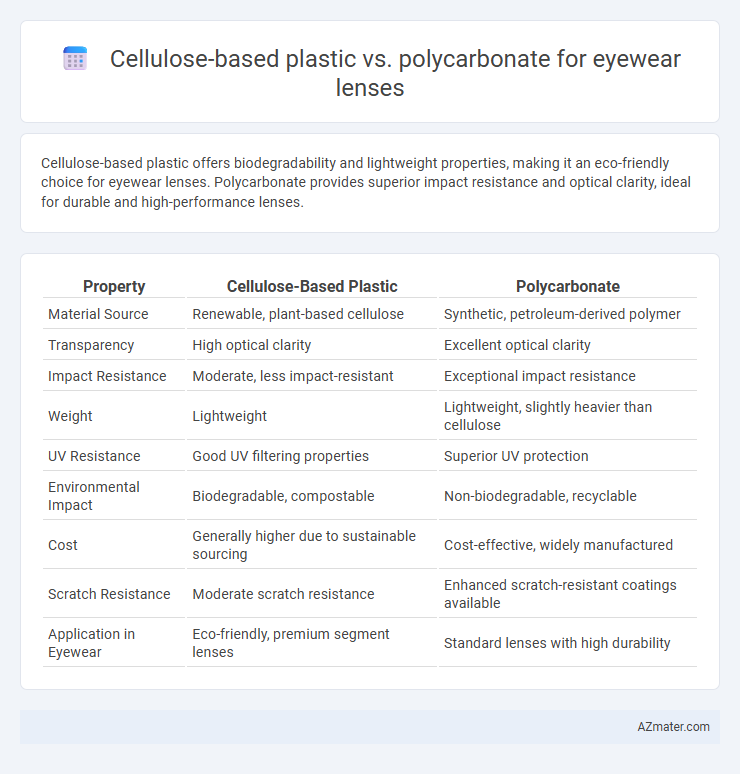Cellulose-based plastic offers biodegradability and lightweight properties, making it an eco-friendly choice for eyewear lenses. Polycarbonate provides superior impact resistance and optical clarity, ideal for durable and high-performance lenses.
Table of Comparison
| Property | Cellulose-Based Plastic | Polycarbonate |
|---|---|---|
| Material Source | Renewable, plant-based cellulose | Synthetic, petroleum-derived polymer |
| Transparency | High optical clarity | Excellent optical clarity |
| Impact Resistance | Moderate, less impact-resistant | Exceptional impact resistance |
| Weight | Lightweight | Lightweight, slightly heavier than cellulose |
| UV Resistance | Good UV filtering properties | Superior UV protection |
| Environmental Impact | Biodegradable, compostable | Non-biodegradable, recyclable |
| Cost | Generally higher due to sustainable sourcing | Cost-effective, widely manufactured |
| Scratch Resistance | Moderate scratch resistance | Enhanced scratch-resistant coatings available |
| Application in Eyewear | Eco-friendly, premium segment lenses | Standard lenses with high durability |
Introduction to Eyewear Lens Materials
Cellulose-based plastics and polycarbonate are prominent materials used in eyewear lenses due to their unique optical and physical properties. Cellulose-based lenses offer excellent clarity and natural UV protection, making them a sustainable choice with biodegradability advantages. Polycarbonate lenses provide superior impact resistance and lightweight comfort, often preferred for sports and safety eyewear where durability is critical.
What is Cellulose-Based Plastic?
Cellulose-based plastic, derived from natural polymers found in wood pulp and cotton fibers, offers a sustainable alternative to traditional polycarbonate lenses for eyewear. Its biocompatible, biodegradable properties make it an eco-friendly choice while maintaining optical clarity and impact resistance essential for lenses. Polycarbonate remains popular for its superior durability and UV protection, but cellulose-based plastics provide an innovative solution balancing environmental impact with performance.
Overview of Polycarbonate Lenses
Polycarbonate lenses are a popular choice for eyewear due to their high impact resistance and lightweight properties, making them ideal for safety glasses and sports eyewear. These lenses offer excellent optical clarity and UV protection, enhancing eye comfort and reducing glare. Unlike cellulose-based plastics, polycarbonate lenses demonstrate superior durability and flexibility, which helps prevent lens shattering and increases wearer safety.
Optical Clarity: Cellulose-Based vs Polycarbonate
Polycarbonate lenses offer superior optical clarity with high light transmission and minimal distortion, making them ideal for precision eyewear applications. Cellulose-based plastic lenses provide good clarity but often exhibit slight haze or lower light transmission due to their natural polymer structure. Optical performance in polycarbonate lenses surpasses cellulose-based options, especially in environments requiring sharp visual acuity and impact resistance.
Durability and Impact Resistance Comparison
Cellulose-based plastic lenses offer moderate durability with good resistance to scratches but tend to be less impact-resistant compared to polycarbonate lenses. Polycarbonate lenses provide superior impact resistance, making them highly durable and ideal for safety and sports eyewear due to their ability to withstand significant force without cracking. The enhanced toughness of polycarbonate ensures longer-lasting protection against drops and impacts than cellulose-based alternatives.
Weight and Comfort Differences
Cellulose-based plastic lenses offer significant weight advantages over polycarbonate, contributing to enhanced comfort for prolonged eyewear use. While polycarbonate lenses are known for their impact resistance, they tend to be heavier, potentially causing pressure on the nose and ears during extended wear. Lightweight cellulose-based lenses reduce fatigue and improve overall comfort without compromising optical clarity.
Environmental Impact and Sustainability
Cellulose-based plastic eyewear lenses offer superior environmental benefits due to their biodegradability and renewable raw materials derived from plant fibers, significantly reducing plastic waste and carbon footprint. Polycarbonate lenses, while durable and impact-resistant, are petroleum-based and contribute to microplastic pollution and higher greenhouse gas emissions during production. Choosing cellulose-based lenses supports circular economy principles and promotes sustainable manufacturing practices in the eyewear industry.
Cost and Accessibility Analysis
Cellulose-based plastic lenses generally offer a lower cost solution compared to polycarbonate lenses, making them more accessible for budget-conscious consumers and mass eyewear production. Polycarbonate lenses, while more expensive due to advanced impact resistance and durability, provide greater value in safety-critical applications such as sports or industrial eyewear. Availability of cellulose acetate materials is widespread, supporting large-scale manufacturing, whereas high-grade polycarbonate requires specialized production processes, influencing its market price and accessibility.
Prescription Adaptability and Versatility
Cellulose-based plastic lenses offer excellent prescription adaptability due to their ease of customization and lightweight nature, making them ideal for complex or high-prescription eyewear. Polycarbonate lenses provide superior impact resistance and are thinner, offering versatility for various frame styles and active lifestyles. Both materials accommodate prescription versatility, but cellulose-based plastics excel in comfort and optical clarity, while polycarbonate prioritizes durability and safety.
Which Lens Material is Best for Eyewear?
Cellulose-based plastic lenses offer superior sustainability and biodegradability, making them ideal for eco-conscious consumers, while polycarbonate lenses provide exceptional impact resistance and lightweight properties, enhancing durability and comfort. Polycarbonate lenses also feature high optical clarity and built-in UV protection, crucial for daily wear and outdoor activities. For eyewear, selecting the best lens material depends on balancing environmental impact with performance needs, with cellulose-based plastics favored for green solutions and polycarbonate leading in safety and versatility.

Infographic: Cellulose-based plastic vs Polycarbonate for Eyewear lens
 azmater.com
azmater.com